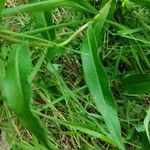Herbs 50-100 cm tall, perennial, with a taproot. Stem usually pale purplish red, erect, branched apically, glabrous, regularly leafy. Leaves thin, glabrous, abaxially glaucous green, adaxially green. Lower and middle stem leaves sessile, lanceolate, narrowly elliptic-lanceolate, or narrowly oblong-lanceolate, 10-26 × 2-3 cm, undivided or more rarely sinuate-dentate to pinnately lobed, base attenuate, auriculately or sagittately clasping, margin entire to faintly denticulate, apex acute to acuminate. Upper stem leaves similar to middle stem leaves but smaller. Synflorescence corymbiform to corymbosely paniculiform, with many capitula. Capitula with ca. 20 florets. Involucre cylindric, 0.9-1.3 cm. Phyllaries often purplish tinged or mottled; outer phyllaries triangular-ovate to lanceolate, apex acute; inner phyllaries ca. 8, apex subobtuse. Florets blue, rarely white. Achene brown to olive green, narrowly ellipsoid, ca. 4 mm, subcompressed, either marginal rib almost as thick as ca. 1/3 of achene diam., middle third with 4 or 5 narrow ribs on either side, apically attenuate or with a ca. 1 mm beak. Pappus 5-7 mm. Fl. and fr. Jul-Sep. 2n = 18*.
More
A herb. It grows 50-100 cm tall. It has a taproot and keeps growing from year to year. The stems are pale purple or red. The leaves are thin and bluish green underneath. The leaves are narrowly oval and 10-26 cm long by 2-3 cm wide. They clasp the stem at the base.
Semiweedy in open forest, willow thickets, forest edges, logged areas and burns, floodplain meadows, near irrigation channels and marshes, old fields and wastelands, sometimes in cultivated fields, sometimes in wormwood or other herbshrub communities.
More
It is a temperate plant. It grows in moist places by river banks and lakes between 300-2,100 m above sea level.

